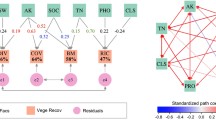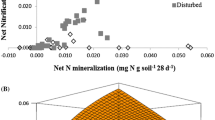Abstract
We present a framework for assessing biogeochemical recovery of terrestrial ecosystems from disturbance. We identify three recovery phases. In Phase 1, nitrogen is redistributed from soil organic matter to vegetation, but the ecosystem continues to lose nitrogen because the recovering vegetation cannot take up nitrogen as fast as it is released from soil. In Phase 2, the ecosystem begins re-accumulating nitrogen and converges on a quasi-steady state in which vegetation and soil-microbial processes are in balance. In Phase 3, vegetation and soil-microbial processes remain in balance and the ecosystem slowly re-accumulates the remaining nitrogen. Phase 3 follows a balanced-accumulation trajectory along a continuum of quasi-steady states that approaches the true steady state asymptotically. We examine the effects of three ecosystem properties on recovery: openness of the nitrogen cycle, nitrogen distribution in and turnover between vegetation and soils, and the proportion of nitrogen losses that are in a refractory form. Openness exacerbates Phase 1 nitrogen losses but speeds recovery in Phases 2 and 3. A high fraction of ecosystem nitrogen in vegetation, resulting from nitrogen turnover that is slow in vegetation but fast in soil, exacerbates Phase 1 nitrogen losses but speeds recovery in Phases 2 and 3. A high proportion of nitrogen loss in refractory form mitigates Phase 1 nitrogen losses and speeds recovery in Phases 2 and 3. Application of our conceptual framework requires empirical recognition of the continuum of quasi-steady states constituting the balanced-accumulation trajectory and a distinction between the balanced-accumulation trajectory and the true steady state.





Similar content being viewed by others
References
Birkhoff GD. 1927. Dynamical systems. Providence: American Mathematical Society Colloquium Publications.https://doi.org/10.1090/coll/009
Blair JM, Seastedt TR, Rice CW, Ramundo RA. 1998. Terrestrial nutrient cycling in tallgrass prairie. In: Knapp A, Briggs JM, Hartnett DC, Collins SL, Eds. Grassland dynamics: long-term ecological research in tallgrass prairie. New York: Oxford University Press. p 222–43.
Bormann FH, Likens GE. 1979. Catastrophic disturbance and the steady state in Northern Hardwood forests: a new look at the role of disturbance in the development of forest ecosystems suggests important implications for land-use policies. Am Sci 67:660–9.
Bormann FH, Likens GE. 1994. Pattern and process in a forested ecosystem. New York: Springer.
Brady NC. 1974. The nature and properties of soils. 8th edn. New York: MacMillan Publishing.
Buffam ID, Galloway JN, McGlathery KJ, Blum LK. 2001. Dissolved organic matter concentrations and bioavailability in an Appalachian stream during storms. Biogeochemistry 53:269–306.
Chapin FSIII, Walker LR, Fastie CL, Sharman LC. 1994. Mechanisms of primary succession following deglaciation at Glacier Bay, Alaska. Ecol Monogr 64:149–75.
Comins HN. 1997. Analysis of nutrient-cycling dynamics, for predicting sustainability and CO2-response of nutrient-limited forest ecosystems. Ecol Mod 99:51–69.
Comins HN, McMurtrie RE. 1993. Long-term response of nutrient-limited forest to CO2 enrichment: equilibrium behavior of plant-soil models. Ecol Appl 3:666–81.
Compton JE, Hooker TD, Perakis SS. 2007. Ecosystem N distribution and δ15 N during a century of forest regrowth after agricultural abandonment. Ecosystems 10:1197–208.
Currie WS, Aber JD, McDowell WH, Boone RD, Magill AH. 1996. Vertical transport of dissolved organic C and N under long-term N amendments in pine and hardwood forests. Biogeochemistry 35:471–505.
Figueiredo V, Enrich-Prast A, Rutting T. 2019. Evolution of nitrogen cycling in regrowing Amazonian rainforest. Nat Sci Rep 9:8538. https://doi.org/10.1038/s41598-019-43963-4.
Gaiser EE, Bell DM, Castorani MCN, Childers DL, Groffman PM, Jackson CR, Kominoski JS, Peters DPC, Pickett STA, Ripplinger J, Zinnert JC. 2020. Long-term ecological research and evolving frameworks of disturbance ecology. Bioscience 70:141–56.
Goodale CL, Aber JD, McDowell WH. 2000. The long-term effects of disturbance on organic and inorganic nitrogen export in the White Mountains, New Hampshire. Ecosystems 3:433–50.
Hedin LO, von Fischer JC, Ostrom NE, Kennedy BP, Brown MG, Robertson GP. 1998. Thermodynamic constraints on nitrogen transformations and other biogeochemical processes at soil–stream interfaces. Ecology 79:684–703.
Hooker TD, Compton JE. 2003. Forest ecosystem carbon and nitrogen accumulation during the first century after agricultural abandonment. Ecol Appl 13:299–313.
Ingestad T, Ågren GI. 1988. Nutrient uptake and allocation at steady-state nutrition. Physiol Plant 72:450–9.
Jenny H. 1941. Factors of soil formation: a system of quantitative pedology. New York: McGraw-Hill.
Jentsch A, White P. 2019. A theory of pulse dynamics and disturbance in ecology. Ecology 100(7):e02734. https://doi.org/10.1002/ecy.2734.
Jiang Y, Rastetter EB, Rocha AV, Pearce AR, Kwiatkowski BL, Shaver GR. 2015. Modeling Carbon-Nutrient interactions during the early recovery of tundra after fire. Ecol Appl 25:1640–52.
Jordan CF. 1985. Nutrient Cycling in tropical forest ecosystems. Chichester: John Wiley and Sons.
Knapp AK, Briggs JM, Hartnettz DC, Collins SL. 1998. Grassland dynamics. New York: Oxford University Press.
Kominoski JS, Gaiser EE, Baer SG. 2018. Advancing theories of ecosystem development through long-term ecological research. Bioscience 68:554–62.
Kranabetter JK, McLauchlan KS, Enders SJ, Fraterrigo JP, Higuera PJ, Morris JE, Rastetter ER, Barnes R, Buma B, Gavin D, Gerhart L, Gillson L, Hietz P, Mack M, McNeil B, Perakis S. 2016. A framework to assess biogeochemical response to ecosystem disturbance using nutrient partitioning ratios. Ecosystems 19:387–95.
Kroeger, KD. 2003. Controls on magnitude and species composition of groundwater-transported nitrogen exports from glacial outwash plain watersheds. Dissertation. Boston University, Boston, Massachusetts, USA.
Lambers H, Raven JA, Shaver G, Smith SE. 2008. Specialized nutrient-acquisition strategies reflect plant adaptations to changing N and P status as soils change over geological time scales. Trends Ecol Evolut 23:95–103.
Lazarus 2.0.4 on http://www.lazarus-ide.org. 2019.
Lovett GM, Goodale CL, Ollinger SV, Fuss CB, Ouimette AP, Likens GE. 2018. Nutrient retention during ecosystem succession: a revised conceptual model. Front Ecol Environ 16:532–8.
Matson PA, Naylor R, Ortiz-Monasterio I. 1998. Integration of environmental, agronomic, and economic aspect of fertilizer management. Science 280:112–15.
Mayes M, Melillo J, Neill C, Palm C, Nyadzi G. 2019. Nitrogen cycle patterns during forest regrowth in an African miombo woodland landscape. J Geophys Res BiogeoSci 124:1591–603.
McHale MR, Mitchell MJ, McDonnell JJ, Cirmo CP. 2000. Nitrogen solutes in an Adirondack forested watershed: importance of dissolved organic nitrogen. Biogeochemistry 48:165–84.
Nagy RC, Rastetter EB, Neill C, Porder S. 2017. Nutrient limitation in tropical secondary forests following different management practices. Ecol Appl 27:734–55.
Newbold JD, O’Neill RV, Elwood JW, Van Winkle W. 1982. Nutrient spiraling in streams: implications for nutrient limitation and invertebrate activity. Am Nat 120:628–52.
Odum EP. 1969. The strategy of ecosystem development. Science 164:262–70.
Odum WE, Odum EP, Odum HT. 1995. Nature’s pulsing paradigm. Estuaries 18:547–55.
Pearce AR, Rastetter EB, Bowden WB, Mack MC, Jiang Y, Kwiatkowski BL. 2015. Recovery of arctic tundra from thermal erosion disturbance is constrained by nutrient accumulation: a modeling analysis. Ecol Appl 25:1271–89.
Perakis SS, Hedin LO. 2002. Nitrogen loss from unpolluted South American forests mainly via dissolved organic compounds. Nature 415:416–19.
Perakis SS, Matkins JJ, Hibbs DE. 2012. N2-fixing red alder indirectly accelerates ecosystem nitrogen cycling. Ecosystems 15:1182–93.
Post WM, Pastor J, Zinke PJ, Stangenberger AG. 1985. Global patterns of soil nitrogen storage. Nature 317:613–16.
Press WH, Flannery BP, Teukolsky SA, Vetterling WT. 1986. Numerical recipes: the art of scientific computing. Cambridge: Cambridge University Press.
Qualls RG, Haines BL, Swank WT, Tyler SW. 2002. Retention of soluble organic nutrients by a forested ecosystem. Biogeochemistry 61:135–71.
Rastetter EB. 2011. Modeling coupled biogeochemical cycles. Front Ecol Environ 9:68–73.
Rastetter EB. 2017. Modeling for understanding v. modeling for numbers. Ecosystems 20:215–21.
Rastetter EB, Ågren GI. 2002. Changes in individual allometry can lead to species coexistence without niche separation. Ecosystems 5:789–801.
Rastetter EB, Shaver GR. 1992. A model of multiple element limitation for acclimating vegetation. Ecology 73:1157–74.
Rastetter EB, Vitousek PM, Field C, Shaver GR, Herbert D, Ågren GI. 2001. Resource optimization and symbiotic N fixation. Ecosystems 4:369–88.
Rastetter EB, Yanai RD, Thomas RQ, Vadeboncoeur MA, Fahey TJ, Fisk MC, Kwiatkowski BL, Hamburg SP. 2013. Recovery from disturbance requires resynchronization of ecosystem nutrient cycles. Ecol Appl 23:621–42.
Rastetter EB, Perakis SS, Shaver GR, Ågren GI. 2005. Carbon sequestration in terrestrial ecosystems under elevated CO2 and temperature: role of dissolved organic N loss. Ecol Appl 15:71–86.
Risser PG, Parton WJ. 1982. Ecosystem analysis of the tallgrass prairie: nitrogen cycle. Ecology 63:1342–51.
Roskoski JP. 1980. Nitrogen fixation in hardwood forests of the northeastern United States. Plant Soil 54:33–44.
Running S. 2008. Ecosystem disturbance, carbon, and climate. Science 321:652–3.
Schimel DS, Braswell BH, McKeown R, Ojima DS, Parton WJ, Pulliam W. 1996. Climate and nitrogen controls on the geography and timescales of terrestrial biogeochemical cycling. Global Biogeochem Cycles 10:677–92.
Segel LA, Slemrod M. 1989. The quasi-steady-state assumption: A case study in perturbation. SIAM Review 31:446–477.
Shaver GRW, Billings WD, Chapin FSIII, Giblin AE, Nadelhoffer KJ, Oechel WC, Rastetter EB. 1992. Global change and the carbon balance of arctic ecosystems. BioScience 42(6):433–41.
Sollins P, Grier CC, McCorison FM, Cromack K Jr, Fogel R, Fredricksen RL. 1980. The internal element cycles of an old-growth Douglas-fir ecosystem in Western Oregon. Ecol Monogr 50:261–85.
Thornton PE, Doney SC, Lindsay K, Moore JK, Mahowald N, Randerson JT, Fung I, Lamarque J-F, Feddema JJ, Lee Y-H. 2009. Carbon-nitrogen interactions regulate climate-carbon cycle feedbacks: results from an atmosphere-ocean general circulation model. Biogeosciences 6:2099–120.
Thornton PE, Lamarque J-F, Rosenbloom NA, Mahowald NM. 2007. Influence of carbon-nitrogen cycle coupling on land model response to CO2 fertilization and climate variability. Global Biogeochem Cycles 21:GB4018.
Thornton PE, Law BE, Gholz HL, Clark KL, Falge E, Ellsworth DS, Goldstein AH, Monson RK, Hollinger D, Falk N, Chen J, Sparks JP. 2002. Modeling and measuring the effects of disturbance history and climate on carbon and water budgets in evergreen needleleaf forests. Agric For Meteorol 113:185–222.
van Cleve K, Dyrness CT, Viereck LA, Fox J, Chapin FS, Oechel W. 1983. Taiga ecosystems in interior Alaska. Bioscience 33:39–44.
Vitousek P. 2004. Nutrient cycling and limitation, Hawai’i as a model system. Princeton: Princeton University Press.
Vitousek P, Matson P. 1984. Mechanisms of nitrogen retention in forest ecosystems: a field experiment. Science 225:51–2.
Vitousek PM, Reiners WA. 1975. Ecosystem succession and nutrient retention: a hypothesis. Bioscience 25:376–81.
Vitousek PM, Cassman CC, Crews T, Field CB, Grimm N, Howarth RW, Marino R, Martinelli L, Rastetter EB, Sprent J. 2002. Towards an ecological understanding of biological nitrogen fixation. Biogeochemistry 57(58):1–45.
Vitousek PM, Porder S, Houlton BZ, Chadwick OA. 2010. Terrestrial phosphorus limitation: mechanisms, implications, and nitrogen-phosphorus interactions. Ecol Appl 20:5–15.
Walker TW, Syers JK. 1976. The fate of phosphorus during pedogenesis. Geoderma 15:1–19.
Whittaker RH, Likens GE, Bormann FH, Eaton JS, Siccama TG. 1979. The Hubbard Brook ecosystem study: forest nutrient cycling and element behavior. Ecology 60:203–20.
Woodmansee RG, Duncan DA. 1980. Nitrogen and phosphorus dynamics and budgets in annual grasslands. Ecology 61:893–904.
Yanai RD. 1992. Phosphorus budget of a 70-Year-Old Northern hardwood forest. Biogeochemistry 17:1–22.
Yanai RD, Vadeboncoeur MA, Hamburg SP, Arthur MA, Fuss CB, Groffman PM, Siccama TG, Driscoll CT. 2013. From missing source to missing sink: long-term changes in the nitrogen budget of a Northern Hardwood Forest. Environ Sci Technol 47:11440–8.
Acknowledgements
This work was supported by the National Science Foundation through Grants DEB-1651722, DEB-1556772, PLR-1603560, DEB-1754835, OPP-1841608, ARC-1603302, and especially the Arctic LTER DEB-1637459. Any opinions, findings, and conclusions or recommendations expressed in this material are those of the authors and do not necessarily reflect those of the National Science Foundation. We would also like to thank the subject editor, Donald DeAngelis, as well as John Pastor and Pierre Quévreux for their helpful comments on the manuscript.
Author information
Authors and Affiliations
Corresponding author
Additional information
This work derived from the conceptual framework used to guide the Arctic Long-Term Ecological Research (ARC LTER) Project titled “LTER: The Role of Biogeochemical and Community Openness in Governing Arctic Ecosystem Response to Climate Change and Disturbance.”
Authors’ contributions
All authors contributed to this conceptual framework, helped interpret the simulations, and helped write the paper.
Electronic supplementary material
Below is the link to the electronic supplementary material.
Rights and permissions
About this article
Cite this article
Rastetter, E.B., Kling, G.W., Shaver, G.R. et al. Ecosystem Recovery from Disturbance is Constrained by N Cycle Openness, Vegetation-Soil N Distribution, Form of N Losses, and the Balance Between Vegetation and Soil-Microbial Processes. Ecosystems 24, 667–685 (2021). https://doi.org/10.1007/s10021-020-00542-3
Received:
Accepted:
Published:
Issue Date:
DOI: https://doi.org/10.1007/s10021-020-00542-3




